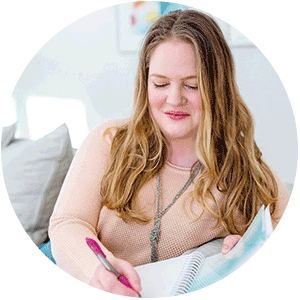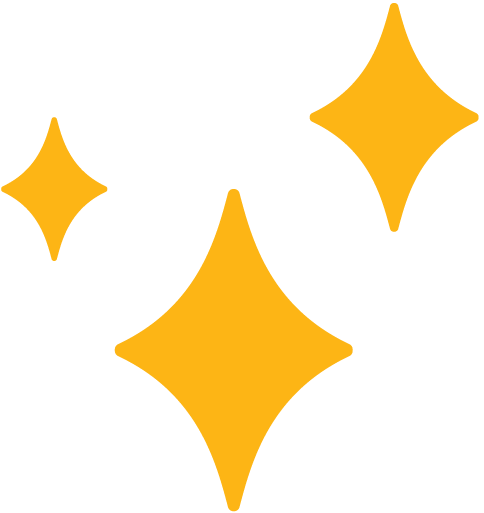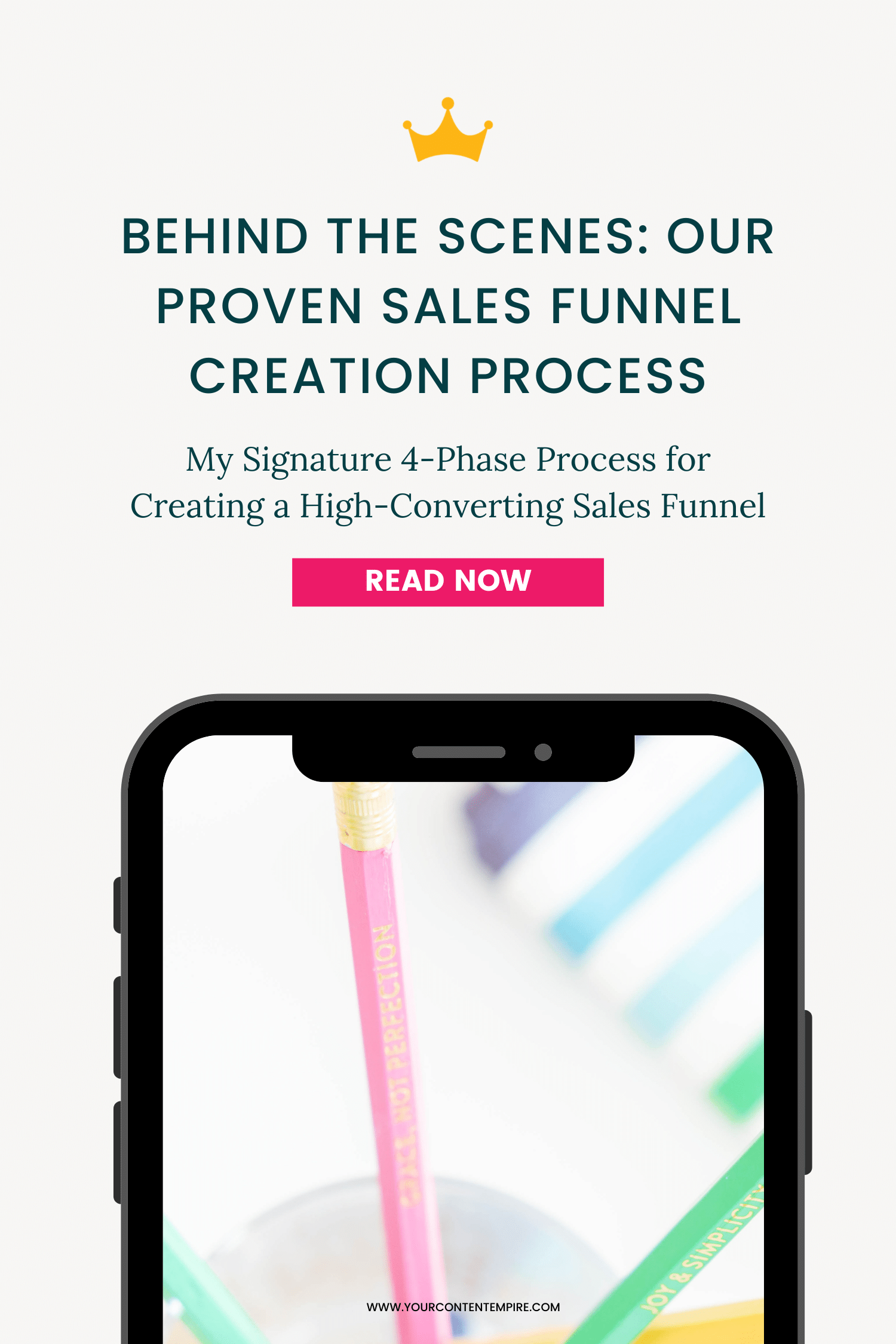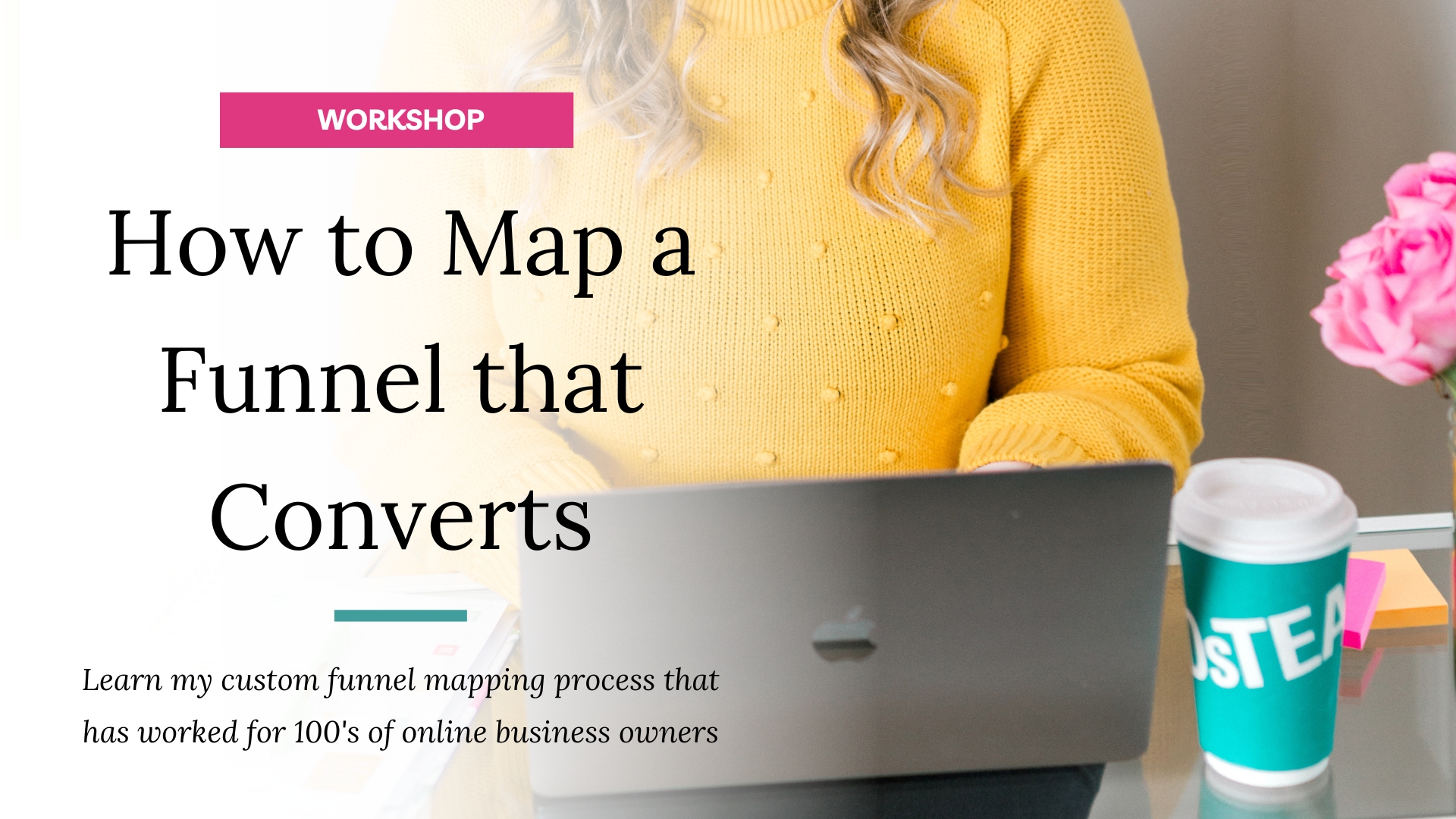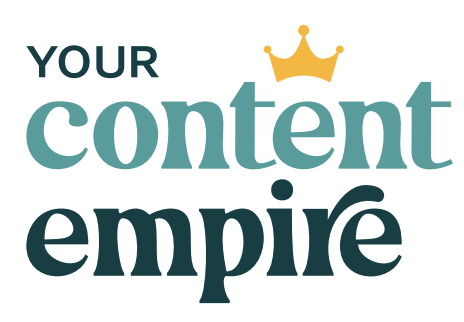Sales funnels have been the bread and butter of my business for the past several years. Since starting my agency almost 8 years ago, I’ve built and consulted on well over 100 sales funnels, in dozens of niches, for any type of offer you could imagine. By now, I feel like I've pretty much seen it all when it comes to sales funnel strategy and have designed a sales funnel process that's proven.
I've also been teaching my process for creating sales funnels through my signature program, the Profitable Funnel Sprint. So in one way or another, everything I teach and do in my business comes down to sales funnels.
Yes, I’m a content strategist, but I’m a believer that until you have a sales funnel in place, all the effort you spend creating content and driving traffic is a wasted effort, in my opinion.
Building all these funnels has helped me come up with a tried and true sales funnel process; one that I get asked about plenty in interviews and summits, and one that I'm excited to share with you. We use this process as a base for every single funnel that we touch, build, and teach in my business—although there's plenty of room tailoring and customizing!
Here’s a full walkthrough of our signature four-phase process for creating an effective, high converting sales funnel.
Phase One: The Kickoff Phase
Every sales funnel project begins with our kickoff phase. This is the phase where we come up with the overarching strategy for the entire sales funnel and create the project plan that we'll be following for the rest of the process. It helps keep the project on track and save us from wasting time going down the wrong path.
We send our clients some in-depth intake homework ahead of time. Then, in a 60-minute strategy session, we review the answers and dig a little deeper—including market research, target client profiles and offer positioning.
With the information gathered and discussed in the strategy session, we go ahead and create the sales funnel map, the sales funnel strategy, as well as the project plan for our clients to approve before we start the next phase of the project.
Case Study: Alli Elmunzer, The Stock Gallery
During the kickoff phase for Alli's project, we discovered that she already had a great freebie in place that worked like gangbusters for her audience! It was the perfect taster for what members would get when they signed up for their membership—a collection of sample stock photos.
We decided that changing the freebie wasn't necessarily the best idea. We instead agreed that we were better off spending our attention and energy on designing a follow-up sequence—a bridge between the freebie and the offer that would make the stock photo membership a total no brainer.
Within our three-month testing phase, Alli had added 50 new members with a 5.3% conversion rate of the sales funnel overall. She also recovered three times of her return on investment (ROI) into our sales funnel package.
I’d like to mention that ROI is a metric that I'm most passionate about in my agency. I always make sure that every time a client achieves that package ROI, we take a moment to celebrate that we're achieving that so quickly. To me, it’s a sign that the process is working!
Phase Two: The Freebie Phase
Once we get the green light approvals from the kickoff phase, it’s time to move on to the freebie phase.
In the freebie phase, we tackle everything to do with the freebie:
- The content
- The design
- Copy for the sign-up system—opt-in page, thank you page, and welcome email
Like in the previous phase, we start with another 60-minute strategy session, although this one is more like a content interview. I like to tell my clients to treat it like a coffee chat or a podcast interview and the process is geared at helping us gather all of the know-how related to the freebie content out of their head and into a raw content. We later get this interview transcribed and use it to draft the content of the freebie.
We use these transcribed content interviews for a couple of different reasons.
Reason #1: We Respect That Our Clients Are The Subject Matter Experts
We could spend years researching and learning about our client's area of genius, and we still wouldn’t come close to knowing everything they do. So this process helps us access and harness their impressive know-how for putting together the highest-value freebie possible that their audiences will flip for.
Reason #2: We Want to Sound Like Our Clients
There's nothing worse than hiring a copywriter and then getting back some drafts which sound nothing like you. By using this interview approach we're able to use our clients’ exact words as much as possible while we clean up and refine the copy.
After the content interview, we create the copy and design drafts for the content freebie. If we’re doing a quiz for example, that would be the quiz questions, the result PDFs, and the opt-in copy. All of this content is sent back to our clients for revisions.
Case Study: Kathie Wiehanne of Bluchic
Kathie hired us to create a sales funnel for her WordPress theme and design template shop. One of her goals with her sales funnel was to both showcase her different types of products, and educate her audience on which ones were right for them.
During the freebie phase of her project, we created the online presence email course which also served as a showcase for her wide range of digital products.
Our stats prove just how much this freebie resonated with her audience. The opt-in page converted at 55.83% with 53 sales during our monitoring phase, and a conversion rate of 6.37% for her funnel overall. By the end of this testing phase, she had reclaimed 2.4 times her investment on our sales funnel package, even though she was selling a smaller price point offer, than say, a big signature course or a one-on one-package.
Phase Three: The Offer Phase
Now that we have the freebie nailed down, we’re focused on building the bridge between this freebie and the paid offer that we're leading up to in the funnel.
In the offer phase, we:
- Write the follow-up emails
- Audit the clients’ sales page (or create one if they've decided to add this onto their package)
- Build and set up the entire sales funnel
Like the freebie phase, this offer phase begins with a content interview. We tell our clients to treat the questions we send over just like they were preparing for a podcast interview or a chat with a friend. We do this to remove any pressure on themselves to sound a certain way since a lot of the magic can come through the editing process.
The content interview helps us get the raw content needed for their email sequence. Using transcripts from the interview, the email sequence is then drafted and sent over for revisions.
At the same time, we do an audit of the sales page and share recommendations for improvement. Some clients choose to hire us to create their sales page as an add-on, but in most cases our clients are already coming to us with a sales page for their offer.
After the email sequence is approved, we move into the building phase where we build out the entire sales funnel with:
- An opt-in page
- A thank you page
- The delivery of the freebie
- Follow up emails
By the time we're done with this phase you’ll have a fully functioning and working sales funnel. When we’re confident the funnel is done and thoroughly tested on our end, we send it all over to our clients to do their own testing and let us know if any final tweaks are needed.
Case Study: Andi Smiles, Bad Ass Business Finance
Every client project is a little bit different, and with Andi Smiles, who sells a bookkeeping course, Bad Ass Business Finance, we did a variation of our typical package that focused solely on the offer phase and email sequences.
We didn’t create a freebie for her sales funnel because we were creating over six months of automated email sequences (my forever funnel method) that would nurture her audience by taking them on a journey and get her paid offers in front of them every five to six weeks. This relieved her from the pressure of having to create content every single week, generated more consistent sales on autopilot and allowed us to leverage the vast amount of content she'd already created.
Through our work together, we not only gave her coverage for six months where she didn't have to worry about creating new content, we also added in a promoted pins campaign which resulted in her adding 1082 people into the forever funnel. Plus got her 35 course sales hitting her goal of 10 sales per month by month five and recovered 3.69 times her investment by the end of that initial testing phase.
Phase Four: The Traffic Phase
In the traffic phase, we create a sales funnel promotion plan and 3-month editorial calendar to help get our client's new freebie out into the world in a BIG way. During a 60-minute strategy session, we discuss how to reach their monthly sales goals as well as the milestones they'll need to hit along the way as they work up to that target.
If our clients have over 500 email list subscribers, we also design our signature testing protocol, where we run their existing email list through the funnel and use the data to tweak and optimize the sales funnel content. Many clients make back their entire investment within this testing and optimization phase and can choose to use all or part of that investment on paid ads with confidence that they'll see an ROI from it.
Case Study: Lauren Bongiorno, Diabetic Health Coach
During Lauren's project, we actually created two sales funnels. One was a consultation call funnel to generate 1-1 coaching clients and the other was for her physical product, The Diabetic Health Journal. We used a sales funnel stacking strategy that transitioned subscribers from one funnel to the next which resulted in a highly effective upsell and downsell process.
Lauren also hired us to create and run Facebook and Instagram ads which added 1490 people to her email list (and the sales funnel) which only had to be turned off because she sold out her journals.
Within the three-month testing phase, Lauren had 108 sales of her Diabetic Health Journal and a 9.76% conversion rate of the product funnel. While the consult funnel generated 52 consultation calls booked and a 6.86% conversion rate. At the end of the day, she recovered 3.4 times her investment on both funnels within three months.
So are you building a sales funnel, or need to build a sales funnel?
I would love to support you and have a couple of different options— a do-it-yourself option or a done for you option.
If you're interested in learning how to build a sales funnel yourself using our signature process (templates, checklists, walkthroughs), you can get the full process in my program: The Profitable Funnel Sprint. You can bring your specific questions to our monthly coaching calls, and get hot seat coaching on your sales funnel.
Want to get started with mapping out a profitable sales funnel for free?
Sign up for my FREE funnel mapping workshop and get my exclusive funnel mapping template ↓
